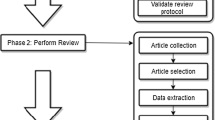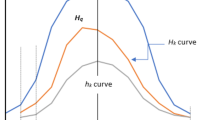Abstract
This paper introduces a methodology for knowledge discovery related to product family design that integrates an ontology with data mining techniques. In the proposed methodology, the ontology represents attributes for the components of products in functional hierarchies. Fuzzy clustering is employed for data mining to first partition product functions into subsets for identifying modules in a given product family and then identify the similarity level of components in a module. Module categorization is introduced to support association rule mining for knowledge discovery related to platform design. We apply the proposed methodology to first develop and then utilize design knowledge for a family of power tools. Based on the developed design knowledge, a new platform is suggested to improve commonality in the power tool family.
Similar content being viewed by others
References
Agard, B., & Kusiak, A. (2004). Data-mining-based methodology for the design of product family. International Journal of Production Research, 42(15), 2955–2969.
Agrawal, R., & Srikant, R. (1994). Fast algorithms for mining association rules in large databases. In 20th international conference on very large data bases (pp. 487–499). Santiago de Chile, Chile.
Bezdek, J. C. (1974). Numerical taxonomy with fuzzy sets. Journal of Mathematics Biology, 1(1), 57–71.
Bezdek, J. C. (1981). Pattern recognition with fuzzy objective function algorithms. New York, NY: Plenum.
Braha, D. (2001). Data mining for design and manufacturing: methods and applications. Dordrecht: Kluwer Academic.
Fayyad, U. M., Piatetsky-Shapiro, G., Smyth, P., & Uthurusamy, R. (1996). Advances in knowledge discovery and data mining. Cambridge, MA: MIT Press.
Gonzalez-Zugasti, J. P., Otto, K. N., & Baker, J. D. (2000). A method for architecting product platforms. Research in Engineering Design, 12(2), 61–72.
Hipp, J., Guntzer, U., & Nakhaeizadeh, G. (2000). Algorithms for association rule mining—a general survey and comparison. ACM SIGKDD Explorations, 2(1), 58–64.
Hirtz, J., Stone, R. B., McAdams, D. A., Szykman, S., & Wood, K. L. (2002). A functional basis for engineering design: reconciling and evolving previous efforts. Research in Engineering Design, 13(2), 65–82.
Jiao, J., & Zhang, Y. (2005). Product portfolio identification based on association rule mining. Computer-Aided Design, 27(2), 149–172.
Jiao, J., Zhang, L., Pokharel, S., & He, Z. (2007). Identifying generic routings for product families based on text mining and tree matching. Decision Support Systems, 43(3), 866–883.
Johnson, R. A., & Wichern, D. W. (2002). Applied multivariate statistical analysis (5th ed.). Upper Saddle River, NJ: Prentice Hall.
Kamrani, A. K., & Salhieh, S. M. (2000). Product design for modularity. Boston, MA: Kluwer Academic.
Liao, T. W. (2001). Classification and coding approaches to part family formation under a fuzzy environment. Fuzzy sets and systems, 122(3), 425–441.
Liao, T. W., & Triantaphyllou, E. (2008). Recent advances in data mining of enterprise data. Singapore: World Scientific.
Miyamoto, S. (1990). Fuzzy sets in information retrieval and cluster analysis. Dordrecht: Kluwer Academic.
Moon, S. K., Kumara, S. R. T., & Simpson, T. W. (2005). Knowledge representation for product design using techspecs concept ontology. In The IEEE international conference on information reuse and integration (pp. 241–246). Las Vegas, NV.
Moon, S. K., Kumara, S. R. T., & Simpson, T. W. (2006). A multi-agent system for modular platform design in a dynamic electronic market environment. In ASME design engineering technical conferences & computers and information in engineering conference, Philadelphia, PA, 10–13 September. ASME, Paper No. DETC2006/CIE-99286.
Moore, W. L., Louvier, J. J., & Verma, R. (1999). Using conjoint analysis to help design product platforms. Journal of Product Innovation Management, 16(1), 27–39.
Muffatto, M., & Roveda, M. (2000). Developing product platforms: analysis of the development process. Technovation, 20(11), 617–630.
Nanda, J., Thevenot, H. J., Simpson, T. W., Stone, R. B., Bohm, M., & Shooter, S. B. (2007). Product family design knowledge representation, aggregation, reuse, and analysis. Artificial Intelligence for Engineering Design, Analysis, and Manufacturing, 21(2), 173–192.
Rai, R., & Allada, V. (2003). Modular product family design: agent-based Pareto-optimization and quality loss function-based post-optimal analysis. International Journal of Production Research, 41(17), 4075–4098.
Romanowski, C. J., & Nagi, R. (2004). A data mining approach to forming generic bills of materials in support of variant design activities. ASME Journal of Computing and Information Science in Engineering, 4(1), 316–328.
Shooter, S. B., Simpson, T. W., Kumara, S. R. T., Stone, R. B., & Terpenny, J. P. (2005). Toward an information management infrastructure for product family planning and platform customization. International Journal of Mass Customization, 1(1), 134–155.
Siddique, Z., & Rosen, D. W. (2000). Product family configuration reasoning using discrete design spaces. In ASME design engineering technical conferences proceedings, Baltimore, MD. ASME, Paper No. DETC00/DTM-14666.
Simpson, T. W. (2004). Product platform design and customization: status and promise. Artificial Intelligence for Engineering Design, Analysis, and Manufacturing, 18(1), 3–20.
Simpson, T. W., Maier, J. R. A., & Mistree, F. (2001). Product platform design: method and application. Research in Engineering Design, 13(1), 2–22.
Simpson, T. W., Siddique, Z., & Jiao, J. (2005). Product platform and product family design: methods and applications. New York, NY: Springer.
Stone, R. B., Wood, K. L., & Crawford, R. H. (2000). A heuristic method for identifying modules for product architectures. Design Studies, 21(1), 5–31.
Swartout, W., & Tate, A. (1999). Ontologies. IEEE Transactions on Intelligent Systems, 14(1), 18–19.
Tarasewich, P., & Nair, S. K. (2001). Designer-moderated product design. IEEE Transactions on Engineering Management, 48(2), 175–188.
Torra, V. (2005). Fuzzy c-means for fuzzy hierarchical clustering. In The IEEE international conference on fuzzy systems (pp. 646–651). Reno, NV.
Ulrich, K. T., & Eppinger, S. D. (2000). Product design and development (2nd ed.). New York, NY: McGraw-Hill.
Xue, D., & Dong, Z. (1997). Coding and clustering of design and manufacturing features for concurrent design. Computer in Industry, 34(1), 139–153.
Yilmaz, E., Triantaphyllou, E., Chen, J., & LIao, T. W. (2003). A heuristic for mining association rules in polynomial time. Mathematical and Computer Modelling, 37(1–2), 219–233.
Zha, X. F., & Sriram, R. D. (2006). Platform-based product design and development: a knowledge-intensive support approach. Knowledge-Based Systems, 19(7), 524–543.
Zhang, Y., Jiao, J., & Ma, Y. (2007). Market segmentation for product family positioning based on fuzzy clustering. Journal of Engineering Design, 18(3), 227–241.
Author information
Authors and Affiliations
Corresponding author
Rights and permissions
About this article
Cite this article
Moon, S.K., Simpson, T.W. & Kumara, S.R.T. A methodology for knowledge discovery to support product family design. Ann Oper Res 174, 201–218 (2010). https://doi.org/10.1007/s10479-008-0349-7
Published:
Issue Date:
DOI: https://doi.org/10.1007/s10479-008-0349-7




